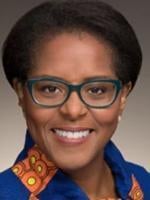The OESA convened its most recent “Mobility Supplier Forum” on August 25th at SRI International on the campus of Stanford University in Palo Alto. This was the first in-person forum hosted in Silicon Valley by OESA in a couple years, and attendee interest was high as thought leaders in the Electrified Mobility space – including EVs, AVs and related infrastructure and other technology areas – shared their views on the current business, technology, legal and regulatory trends facing the mobility industry.
The agenda included presentations from Daron Gifford, who leads Plante Moran’s automotive strategy consulting practice based in Detroit; and James Buczkowski, who oversees Ford Motor Company’s labs in Silicon Valley as Executive Director, Research and Advanced Engineering. Foley & Lardner’s Natasha Allen, a Partner in the Firm’s Northern California offices, moderated a panel discussion with Foley D.C. partners Chris Grigorian, NHTSA lead at Foley, and Mike Walsh, formerly General Counsel at the Department of Commerce who focuses on federal regulatory matters. Chris and Mike focused on legal and regulatory developments impacting automotive and mobility technology.
The California setting provided a poignant backdrop for the discussion, as that same day, the State of California approved regulations (including proposed targets) for California’s walk (more like a run) to zero ICE passenger vehicles by 2035. Left unanswered in this backdrop was whether the EV infrastructure in California and the rest of the U.S. – whose grids are already stressed – will be able to meet such aggressive timelines, and will consumer demand behave as expected, which are two key drivers in reaching ambitious EV deployment goals in the U.S.
Daron Gifford began by citing the three principle drivers of industry transformation: Propulsion and Energy Technologies (including battery and materials supply chain, electric drives, charging infrastructure, battery recycling and second use and energy storage systems), Mobility (including autonomous driving, mobility as a service, connectivity and retail services – operations, repair, maintenance and parts) and Engineering, Manufacturing and Logistics (including engineering, design and program launch, cost reduction and manufacturing process simplification, supply chain and distribution efficiency and sustainability of manufacturing and supply).
Gifford predicted EV penetration of 58% by 2035, with a global growth in EVs over the period 2022 -2035 at a CAGR of 22%. Suppliers must manage this shift away from ICE vehicles (which average around 10,000 parts) to EVs (which average around 3,000 parts). He noted the planned investment in North America of 23 battery gigafactories to help meet expected EVs demand in the U.S., with approximately 825 GWh of planned battery capacity to be installed in North America by 2031. Gifford noted that three critical elements are required by consumers for mass EV adoption: price parity with ICEs, minimum range of 300 miles and adequate charging infrastructure. Four sources will contribute to meeting the Energy Storage System capacity needed to support the EV influx: grid/utilities, commercial/industrial, EV charging and residential, with effective distribution being the biggest challenge to meeting EV deployment goals.
Gifford spoke briefly about Mobility and AVs as well, noting that a lot of the “driven” AV miles will be shared miles, with vehicles expected to turn over every 3 - 4 years (significantly lower than the current 12-year average car park in the U.S.). Mobility as a Service is expected to be a $2.5 trillion market by 2027 and $5.7 trillion by 2050, which is commanding a lot of attention.
The panel began with an overview of recent legislation promoting the adoption of EVs, including the CHIPS Act and the Bipartisan Infrastructure Law which included $7.5B of funding for EV infrastructure and several rulemaking mandates on NHTSA. Mike Walsh then noted certain confusion around the EV provisions in the Inflation Reduction Act of 2022, which is expected to be ironed out in future reconciliation bills. On the AV side, Chris Grigorian was hopeful that the recent formation of a bipartisan “Autonomous Vehicle Caucus” in Congress, that includes Reps. Dingell and Latta, will serve as an impetus for finalizing AV legislation that stalled out a few years ago. That legislation is expected to deal with, among other things, preemption of the existing patchwork of state laws and cybersecurity topics. Walsh noted that the imposition of “Buy America” requirements create opportunities for the U.S. to enter into free trade agreements to help create a more resilient supply chain with content that will hopefully satisfy these requirements. He also noted the Forced Labor Act requirements that apply to all raw materials, components and subcomponents coming out of the Xinjian region of China (“even a single grain of silicate is covered,” he noted), and the related due diligence burdens placed on the automotive supply chain.
Grigorian then gave a deep dive into NHTSA’s current crash protection, crash avoidance, other rulemaking actions, as well as the agency’s investigative activities, including a Standing General Order requiring more than one hundred vehicle manufacturers, suppliers, and vehicle operators to report to NHTSA certain crashes that involve vehicles using Level 2 (L2) ADAS and L3 and above automation. Grigorian noted that NHTSA (like other Federal rulemaking agencies) is required to publish a Unified Agenda every six months, with estimated timelines for rulemaking and other actions, and that Agenda is as robust as it has ever been.
In assessing what the next couple years may look like, Walsh predicted keen and increasing Congressional interest in protecting U.S. industry as part of our national security and supply chain resiliency, with an even greater focus on protecting technology, monitoring relationships with China and controlling the export or deemed export of technology to overseas operations of U.S. companies. He also noted that the recent economic sanctions imposed on Russia demonstrate what the expected playbook of U.S. sanctions may look like in the event of any serious degradation in the U.S.- China relationship, particularly in the context of increasing hostility toward Taiwan, and that automotive suppliers and other mobility companies should work with legal counsel now to stress test/assess their resiliency and response to potentially destabilizing events.
In the areas of current NHTSA research and rulemaking, Grigorian noted research in the areas of AVs, ADAS, Battery Management Systems, and cybersecurity, and rulemaking activities directed at removing regulatory barriers for AVs and Automated Driving Systems. He also noted current investigations into AVs, ADAS, and other advanced technologies. His message to automotive suppliers: “we [suppliers] are on NHTSA’s radar screen more than we have ever been.”
Jim Buczkowski from Ford then highlighted the disruption and change facing the industry. “There has never been a period like this” in his 40+ years in the industry, in terms of the pace and simultaneous concurrence of these disruptive factors. He highlighted the four key trends that Ford is managing: (1) Digital Transformation/Digitizing the Enterprise, (2) Transition to a Sustainable World, (3) Enabling the 21st Century Workforce and (4) Creating 21st Century Resilience. These challenges come at a time of unprecedented competition from both traditional OEMs and large technology players, as well as myriad startups and other mobility players; “every part of our business is being challenged at the same time.” Such disruption was one of the factors driving Ford’s separation of its Model e (EV) and Ford Blue (ICE) businesses, and to use Ford’s legacy as a building block rather than an impediment to its necessary transformation.
Buczkowski noted six areas of “unprecedented, simultaneous disruption”:
-
Product/Technology
-
AV/ADAS
-
Supply Chain and Distribution
-
Sustainability
-
Competitors
-
People
Each of these alone would be a huge driver of disruption; taken together they represent a huge challenge for Ford and all other players in the mobility space. He later noted that “supplies for batteries is going to be the next chip crisis” if not managed effectively. Buczkowski also noted that the ICE-to-BEV transaction will result in an estimated 30% reduction in capacity utilization in the supply base, which must be carefully managed and supported. Finally, he also noted the migration to several “high performance compute centers” in the vehicle vs. the current array of dozens of systems each interfacing with the vehicle’s CAN bus, requiring even greater computational power and system integration.







 />i
/>i

